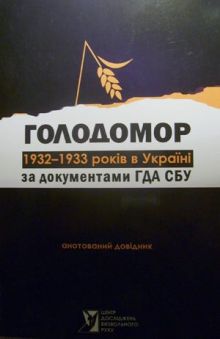Donetsk – On the last day of fall Donetsk saw a presentation of the book The Holodomor of 1932 -1933 in Ukraine According to the Documents of the Branch State Archives of the Security Service of Ukraine: An Annotated Handbook, published several days earlier by the Lviv-based Liberation Movement Research Center, with support of the World Congress of Ukrainians, Ukrainian Genocide Foundation, and other international Ukrainian organizations.
The book’s almost 500 pages contain the list, detailed description, and analysis of the 420 declassified documents of the Branch State Archives of the SBU, as well as names and geographical indices of individuals, cities, towns, villages, regions, and countries mentioned in the documents.
Classified according to their origin into seven categories (office records and correspondence, normative and order documents, evidence from private sources, etc.), the declassified SBU documents allow one to make a comprehensive analysis of the technology and progress of the implementation of the Holodomor, its consequences, and measures taken to hush up this crime.
In particular, among the secret records and letters one can find not only the correspondence dating back to the times of the tragedy (including the letters personally belonging “to Comrade Stalin”), but also the documents of Volodymyr Shcherbytsky’s time, containing information about the Ukrainian events in the US to commemorate the 50th anniversary of the man-made famine in Ukraine, and counteractive measures.
No less important and informative are the sources of private origin, first of all, the diaries of the eye-witnesses. For example, the diary of Bilous, a collective farmer from the village of Lebiazhe, Kharkiv oblast, contains a detailed description of the events in the country in 1923-33, and of life in Kharkiv when the famine was at its height.
More than a half of the declassified documents are made up of archive criminal cases opened on the charge of “anti-Soviet propaganda,” i.e. spreading information about the starving and depopulated villages and towns. The collection is concluded with the materials of criminal case No. 475, opened in 2009, on the fact of deliberate murder by starvation of more than 3.4 million of Ukrainian citizens.
After the presentation itself, conducted by the coordinator of the Civic initiative of Donetsk oblast for restoration of historical memory Stanislav Fedorchuk, the audience was informed about the existing situation in regards to Holodomor studies in Donetsk oblast. The report was made by the historian Stanislav Bliednov, Ph.D., author and editor of numerous publications about the Holodomor in the Donetsk Basin. According to the researcher, so far two volumes of the National Book of Memory concerning Donetsk oblast have been published (the total number is 18 volumes), in which, besides research papers and eyewitness evidence, a martyrology, or nominal list of the victims in the oblast, is incorporated.
At present, it includes more than 100,000 items, but the actual number of victims is much higher; at least half of death records have not survived, or were simply not made at all. Thus, in Bliednov’s birthplace, the Mariine raion of Donetsk oblast, almost half of the inhabitants died in each village, while the official records have fixed only a couple dozen deaths.
On the whole, the materials collected by the collegium are sufficient to make up another two thick volumes. The only problem is financing, which has been cut this year. “Nonetheless, research work and publishing activities will continue,” assured the scholar.
We would only like to add that academic publications are not the only yield of Donetsk historians. Besides several research and journalistic articles, manuals, etc., the collegium has also prepared and published a collection of children’s drawings, The Holodomor Through Children’s Eyes.
Serhii Stukanov is a member of Foundation Board of the Ostroh Free Youth Intellectual Exchange Club







